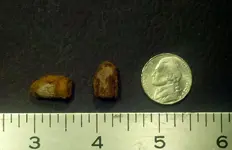It is actually not "corrosion," it is concretion. The difference in the meaning of those words is important. When those words are used in reference to excavated relics, corrosion means deterioration (an "eating away") of a metal relic. Concretion is a build-up of other material on top of the relic's original surface.
I've dug many bullets which show thick brown-ish concretion atop the bullet's original surface. That typically occurs in highly acidic damp soil... such as low-ground near a marsh, creek, swamp, or in a pine forest.
Your photo shows you've scraped away some of the concretion, exposing the bullet's original surface. That surface looks somewhat green-ish. If it actually IS green-ish, that would indicate your bullets are "copper-jacketed" bullets. (The lead bullet has a thin copper covering over the lead.) Copper-jacketed bullets date from around 1900 to the present.
If the somewhat green-ish color is just an optical illusion (and thus they are not copper-jacketed), I'll set aside that issue in order to answer your question. You asked "Are these period or modern?" I assume by "period" you mean civil war period. Your bullets' short length, small diameter, and body-shape indicate they are pistol bullets from the latter-1800s into the 20th-Century, not from the civil war era.



